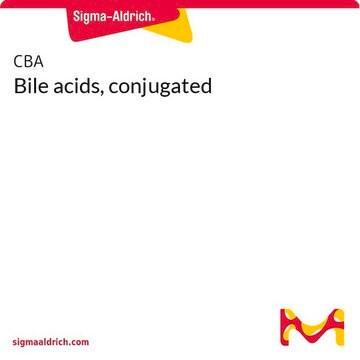C4650
Cholestyramine resin
Synonym(s):
Colestyramine, Dowex 1X2 Cl--Form
Sign Into View Organizational & Contract Pricing
All Photos(1)
About This Item
Recommended Products
form
powder
technique(s)
activity assay: suitable
matrix
polystyrene/divinylbenzene
pH
4—6
capacity
~1.0 meq/g(dry)
Application
Cholestyramine resin has been used:
- as a diet supplement to study the bile acid pool size and fecal bile acid output in mice
- to alter the bile acid (BA) levels and study its effect on liver fibrosis development in wild type (WT), fibroblast growth factor 15 (Fgf15)−/−, and Fgf15 transgenic (TG) mice
- in in vitro digestion process to study the capacity of the fractions for binding bile acid (BA)
Cholestyramine resin is used in protein chromatography, ion exchange chromatography and anion exchange media. Cholestyramine has been used to study the relief of postcholecystectomy diarrhea, the management of intractable cholestatic pruritus and obesity.
Biochem/physiol Actions
Cholestyramine is a cationic exchange resin polymer. This resin is a bile acid sequestrant that interchanges chloride anions for bile acids of the small intestine lumen, leading to excretion of bile acids in the feces and reduced levels of serum bile acid. Cholestyramine is used to treat primary hypercholesterolemia. The resin induces dose-dependent reduction of low-density lipid (LDL) cholesterol. It ameliorates the risk of coronary artery disease.
Other Notes
Quartenary ammonium functional groups attached to cross-linked polystyrene
Legal Information
Storage Class Code
11 - Combustible Solids
WGK
WGK 2
Flash Point(F)
Not applicable
Flash Point(C)
Not applicable
Personal Protective Equipment
dust mask type N95 (US), Eyeshields, Gloves
Certificates of Analysis (COA)
Search for Certificates of Analysis (COA) by entering the products Lot/Batch Number. Lot and Batch Numbers can be found on a product’s label following the words ‘Lot’ or ‘Batch’.
Already Own This Product?
Find documentation for the products that you have recently purchased in the Document Library.
Customers Also Viewed
Ju-Ling Liu et al.
PLoS genetics, 8(3), e1002553-e1002553 (2012-03-23)
Mammalian bile acids (BAs) are oxidized metabolites of cholesterol whose amphiphilic properties serve in lipid and cholesterol uptake. BAs also act as hormone-like substances that regulate metabolism. The Caenorhabditis elegans clk-1 mutants sustain elevated mitochondrial oxidative stress and display a
Noémie Péan et al.
Hepatology (Baltimore, Md.), 58(4), 1451-1460 (2013-05-21)
Many regulatory pathways are involved in liver regeneration after partial hepatectomy (PH) to initiate growth, protect liver cells, and sustain functions of the remnant liver. Bile acids (BAs), whose levels rise in the blood early after PH, stimulate both hepatocyte
Robert W Crawford et al.
PLoS pathogens, 8(9), e1002918-e1002918 (2012-10-03)
Intestinal inflammation changes the luminal habitat for microbes through mechanisms that have not been fully resolved. We noticed that the FepE regulator of very long O-antigen chain assembly in the enteric pathogen Salmonella enterica serotype Typhimurium (S. Typhimurium) conferred a
Guillermo Rodríguez-Gutiérrez et al.
Journal of agricultural and food chemistry, 62(36), 8973-8981 (2014-08-21)
A process based on a steam explosion pretreatment and alkali solution post-treatment was applied to fractionate olive stones (whole and fragmented, without seeds) and olive cake into their main constitutive polymers of cellulose (C), hemicelluloses (H), and lignin (L) under
A R Bolier et al.
Acta gastro-enterologica Belgica, 75(4), 399-404 (2013-02-14)
Pruritus can be the dominant symptom of cholestatic liver disease but is difficult to treat since unraveling its pathophysiology is a great challenge. Serum autotaxin activity correlates with pruritus intensity, but its causal relationship, expression pattern and exact mode of
Our team of scientists has experience in all areas of research including Life Science, Material Science, Chemical Synthesis, Chromatography, Analytical and many others.
Contact Technical Service












